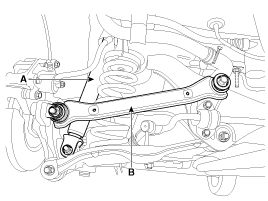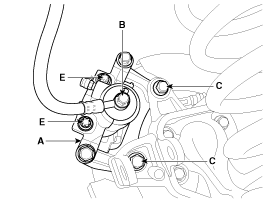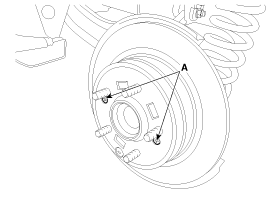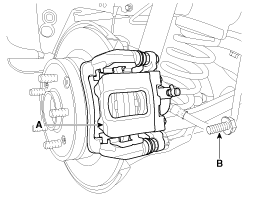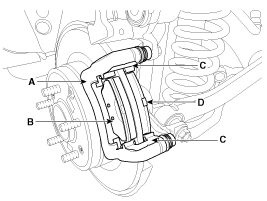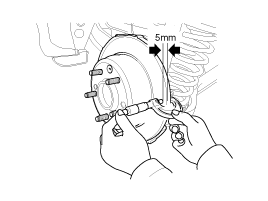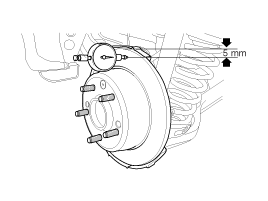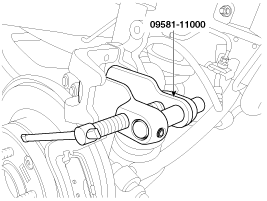 Hyundai Sonata: Rear Disc Brake. Repair procedures
Hyundai Sonata: Rear Disc Brake. Repair procedures
Removal
| 1. |
Remove the rear wheel & tire.
|
| 2. |
Remove the rear shock absorber (A).
(Refer to the Suspension group - rear shock absorber)
https://zvka.ru ą┤ą░čćąĮčŗąĄ čāčćą░čüčéą║ąĖ +ą▓ ą┐ąŠą┤ą╝ąŠčüą║ąŠą▓čīąĄ ąĮąĄą┤ąŠčĆąŠą│ąŠ č鹊ą┐ 100 čüą░ą╝čŗčģ ą┤ąĄčłąĄą▓čŗčģ čāčćą░čüčéą║ąŠą▓.
|
| 3. |
Remove the rear upper arm (B).
|
| 4. |
Loosen the hose eyebolt (B) and caliper mounting bolts (C), then
remove the rear caliper assembly (A).
|
| 5. |
Remove the rear brake disc by loosening the screws (A).
|
Replacement
Rear brake pads
| 1. |
Loosen the guide rod bolt (B) and pivot the caliper (A) up out
of the way.
|
| 2. |
Replace pad shim (D), pad retainers (C) and brake pads (B) in
the caliper bracket (A).
|
Inspection
Rear Brake Disc Thickness Check
| 1. |
Check the brake pads for wear and fade.
|
| 2. |
Check the brake disc for damage and cracks.
|
| 3. |
Remove all rust and contamination from the surface, and measure
the disc thickness at 8 points, at least, of same distance (5mm) from
the brake disc outer circle.
|
| 4. |
If wear exceeds the limit, replace the discs and pad assembly
left and right of the vehicle.
|
Rear Brake Pad Check
| 1. |
Check the pad wear. Measure the pad thickness and replace it,
if it is less than the specified value.
|
| 2. |
Check that grease is applied, to sliding contact points and the
pad and backing metal for damage.
|
Rear Brake Disc Runout Check
| 1. |
Place a dial gauge about 5mm (0.2 in.) from the outer circumference
of the brake disc, and measure the runout of the disc.
|
| 2. |
If the runout of the brake disc exceeds the limit specification,
replace the disc, and then measure the runout again.
|
| 3. |
If the runout exceeds the limit specification, install the brake
disc after turning it 180┬░ and then check the runout of the brake disc
again.
|
| 4. |
If the runout cannot be corrected by changing the position of
the brake disc, replace the brake disc.
|
Installation
| 1. |
Installation is the reverse of removal.
|
| 2. |
Use a SST (09581-11000) when installing the brake caliper assembly.
|
| 3. |
After installation, bleed the (Refer to Brake system bleeding)
|
|
 Rear Disc Brake. Components and Components Location
Rear Disc Brake. Components and Components Location
Components
1. Guide rod bolt
2. Bleed screw
3. Caliper bracket
4. Caliper body
5. Inner pad shim
6. Brake pad
7. Pad retainer
...
See also:
Components and Components Location
Components Location
1. AVN (A/V & Navigation head unit)
2. Midrange speaker
3. External amplifier
4. Roof antenna (GPS + SDARS)
5. Front door speaker
6. Rear spe ...
Cup holder
WARNING - Hot liquids
Do not place uncovered cups of hot liquid in the cup holder while the
vehicle is in motion. If the hot liquid spills, you may burn yourself. Such
a burn to the driver c ...
Engine compartment
■ 2.4 GDI
1. Engine coolant reservoir
2. Engine oil filler cap
3. Brake fluid reservoir
4. Air cleaner
5. Fuse box
6. Positive battery terminal
7. Negative battery terminal
8. Windshie ...

